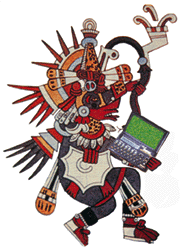 ¿Hablas CyberSpanglish?
¿Hablas CyberSpanglish?
You might find that you already
do!
By Yolanda M. Rivas
It began on the computer desktops of Spanish-speaking
people and continues to spread across the globe as a growing number of
Hispanics tap into the Internet. As the world grows more computer-connected,
Spanish-speaking users of computers and the global computer matrix have
had to come up with inventive ways to explain what they do:
Voy a emailearlo ahorita; zoomea más para verlo más
grande; necesito rebutear la computadora otra vez.
It is a Spanglish for computers -- a CyberSpanglish. It's a hybrid,
distinct from the street Spanglish of U.S. cities, that was created to
solve perplexing problems such as how to say "click on a hypertext link
or an icon": ¡Cliquéalo, pues! Latino users on-line
unconsciously have revolted against their language's old rules and traditions
and have created a communal identity for the Information Age. Thus, CyberSpanglish
is not only a sign of the evolution of a language, but of its people-those
who are bound through computer networks and who create their own set of
codes to communicate efficiently about the new technology.
Consequently, many hybrid terms have become acceptable forms of speech.
Some English jargon doesn't have equivalents in Spanish. In these cases,
users are familiar with emailear (to e-mail) instead of enviar
por correo electrónico, or linkear (to link) instead
of enlazar, or el Web (the Web) instead of la Telaraña.
Such tongue twisters as hacer un golpecito seco (click) have
left Spanish-speaking computer users less than loyal to Spanish-only. At
the same time, many computer-savvy Latinos also speak English, giving them
both the opportunity and the means to create CyberSpanglish. Working with
"English-speaking machines," these generally well-educated Cyberlatinos
are continually creating new ways to talk about the infobahn. Technology
has taken on the lexicon of its creators: U.S. speakers of English, straining
the vocabulary limits not only of Spanish, but local languages around the
world.
To some, the change threatens the purity of cultures. Others embrace
it as a necessary evolution, a way of communicating what has to be communicated.
The Internet and its lingua franca, English, have arrived in Spanish-speaking
on-line communities, and two cultures have become more intertwined. The
transformation could even be compared to other crossroads that shaped other
languages: the Arab/Berber invasion of Iberia, which gave Spanish speakers
Arab words they used in a Latin way, or the Norman conquest, which gave
English so many French words to use in a Germanic language. Like the Spanish
and the English, Cyberlatinos are borrowing, but they are using terms in
their own, uniquely Spanish, way.
In the middle of conversations, on-line messages, and computer
documentation, Cyberlatinos spring forth with CyberSpanglish terms, creating
hybrids of English and Spanish to fit their needs. Just like Puerto Ricans
in New York or Mexican Americans in the Southwest, Latinos on-line use
elements of both English and Spanish while maintaining the basic Spanish
word order and pronunciation of the borrowed terms. Users of CyberSpanglish
often make use of words without translation; as English verbs conjugated
in Spanish (emailear); and as Spanish words with new meanings because
they sound similar to the English word (fuentes for fonts). The
phenomenon has become so prevalent that forums exist on the Internet on
the subject.
As technology evolves, so will Spanish. There's little doubt CyberSpanglish
will remain a dynamic phenomenon throughout Latino on-line communities
at the office, at school, and even at home. While some may argue that CyberSpanglish
is some type of impure language, in order for the Spanish-speaking world
to keep up with technology, it must be able to communicate its concepts.
Evaluating CyberSpanglish terms aids in the design of new computer terminology
that is needed in the Spanish language. The innovation of new terms will
encourage Spanish-speakers to use more formalized vocabulary as opposed
to hybrid terms, which are often improvised without much thought.
Latino on-line communities are choosing to move forward with the
technology. Language is changing at the pace of technology.
Editor's Note: As part of a CyberSpanglish
project, author Yolanda Rivas, a University of Texas-Austin graduate student
and the associate editor of HISPANIC Online, collected more
than 500 terms and organized them on a World Wide Web site. Point your
Web browser to http://www.actlab.utexas.edu/~seagull/
spanglist.html to find English, CyberSpanglish, and Spanish equivalents
of more than 500 computer terms. HISPANIC Online is the Web site of HISPANIC
Magazine and can be accessed at http://www.hisp.com.
|TOP|
|Back to April
96 Table of Contents|
|Latino Internet
Links|